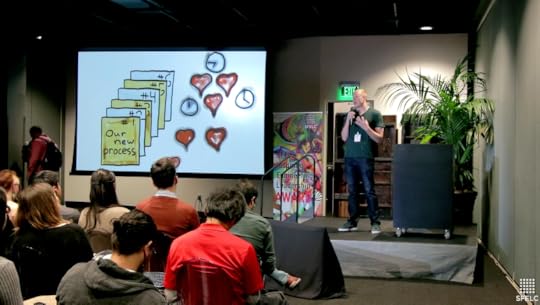Will Larson's Blog, page 32
December 19, 2019
Incident response, programs and you(r startup).

During an incident at Digg, a coworker once quipped, “We serve funny cat pictures, who cares if we’re down for a little while?” If that’s your attitude towards reliability, then you probably don’t need to formalize handling incidents, but if you believe what you’re doing matters – and maybe today’s a good time to start planning how to walk out that door if you don’t – then at some point your company is going to have to become predictably reliable.
Having worked with a number of...
December 9, 2019
Mail bag for December 2019: when your team wants your job, personal brand, and service registries.
Thanksgiving week started well, and then took a hard pivot towards influenza, which meant that I haven’t had much energy to write or think over the past bit. I did get a handful of interesting questions emailed in though, so I figured I’d do an email grab bag of three anonymized questions that came in over the past week and an answer to each.
When your team competes with youThe first question is a particularly challenging one, dealing with a team member who wanted your job when you were...
November 25, 2019
Maintaining platform-product fit.
In 2011, Steve Yegge wrote his Google Platforms Rant, which states "the Golden Rule of platforms is that you Eat Your Own Dogfood," arguing that APIs are good to the extent that the folks developing them depend on their quality and feature coverage. The memo came to mind earlier this week when a coffee chat with a friend veered towards their conviction that Google Cloud lacks necessary functionality because folks within Google simply don't build upon their cloud offering. Amazon, conversely,...
November 23, 2019
"How to successfully design organizational processes"

The first piece I wrote in 2019 was about good process being evolved rather than designed in a one-off fashion, which served as the basis for a talk I gave at SFELC's January 2019 conference.
Watch the video from that talk on the SFELC site, featuring some of my favorite slides I've ever made. Of the talks I've given so far, this one is both literally and figuratively unique because I custom made it for the event, and have only given it that one time.
While the video isn't embeddable click...
November 22, 2019
"Do engineering managers need to be technical?" in Increment.

The most recent issue of Increment came out, focusing on Teams, and I'm excited to get to cross the chasm and move from playing a(n extraordinarily small) role in the founding of Increment to contributing a piece on whether engineering managers need to be technical.
Getting to write in more mediums and formats has been some of the most fun I've had writing this year–one more small project I've contributed to is coming next month–and this one is particularly close to my heart,...
"Do Engineering managers need to be technical?" in Increment.

The most recent issue of Increment came out, focusing on Teams, and I'm excited to get to cross the chasm and move from playing a(n extraordinarily small) role in the founding of Increment to contributing a piece on whether engineering managers need to be technical.
Getting to write in more mediums and formats has been some of the most fun I've had writing this year–one more small project I've contributed to is coming next month–and this one is particularly close to my heart,...
November 18, 2019
Expanding on S[a-z]{3,} Reliability Engineer roles.
One of my foundational learning experiences occurred in 2014, when I designed and rolled out Uber’s original Site Reliability Engineering role and organization. While I’d make many decisions a bit differently if I could rewind and try again, for the most part I’m proud when reviewing the reel of rewound memories.
Folks will occasionally ask my advice on introducing SRE in their company, and I give them an answer they don’t expect: don’t. The one word version comes across rather more controversial than I i...
November 15, 2019
Notes on Building Evolutionary Architectures.
I recently picked up Building Evolutionary Architectures by Ford, Parsons and Kua. It occupies a similar spot in my head as Accelerate and A Philosophy of Software Design, in the category of seasoned software practitioners sharing their generalized approach to software. Altogether, I rather enjoyed it, and it more elegantly explains many of the points I attempted to make in Reclaim unreasonable software.
Below are my notes from Building Evolutionary Architecture.
SummaryThe book starts by asking a question that I’ve grappled with frequently: “How is...
November 14, 2019
You only learn when you reflect.
Early in your career, the majority of problems you work on are difficult because they are new for you. You’ve never done it before, and it’s challenging to do good work on problems you’ve never encountered before. However, the good news is that there are other folks on your team who’ve done it before and are already experienced with its in’s and out’s.
Even for garden-variety challenges, it’s easy to spend a disproportionate amount of energy trying to work through the problem before asking for help. Worki...
November 11, 2019
Distributing your Slack application.
We've been working on the reflect Slack application for a while, and it's almost done. We just have to make it possible for other folks to install it. The golden standard of distribution is Slack's App Directory, which makes it easy for folks to find and install your app.
We won't quite get our toy app into the App Directory, but we will make it possible for other folks to install it into their workspaces, at which point you could submit it to the directory if you wanted.
We've already done quite a bit, we just need to inte...



